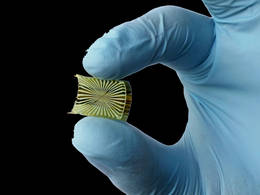I’m guessing that graphene will feature in these proposed cortical implants since the project leader is a member of the Graphene Flagship’s Biomedical Technologies Work Package. (For those who don’t know, the Graphene Flagship is one of two major funding initiatives each receiving funding of 1B Euros over 10 years from the European Commission as part of their FET [Future and Emerging Technologies)] Initiative.) A Jan. 12, 2017 news item on Nanowerk announces the new project (Note: A link has been removed),
BrainCom is a FET Proactive project, funded by the European Commission with 8.35M€ [8.3 million Euros] for the next 5 years, holding its Kick-off meeting on January 12-13 at ICN2 (Catalan Institute of Nanoscience and Nanotechnology) and the UAB [ Universitat Autònoma de Barcelona]. This project, coordinated by ICREA [Catalan Institution for Research and Advanced Studies] Research Prof. Jose A. Garrido from ICN2, will permit significant advances in understanding of cortical speech networks and the development of speech rehabilitation solutions using innovative brain-computer interfaces.
A Jan. 12, 2017 ICN2 press release, which originated the news item expands on the theme (it is a bit repetitive),
More than 5 million people worldwide suffer annually from aphasia, an extremely invalidating condition in which patients lose the ability to comprehend and formulate language after brain damage or in the course of neurodegenerative disorders. Brain-computer interfaces (BCIs), enabled by forefront technologies and materials, are a promising approach to treat patients with aphasia. The principle of BCIs is to collect neural activity at its source and decode it by means of electrodes implanted directly in the brain. However, neurorehabilitation of higher cognitive functions such as language raises serious issues. The current challenge is to design neural implants that cover sufficiently large areas of the brain to allow for reliable decoding of detailed neuronal activity distributed in various brain regions that are key for language processing.
BrainCom is a FET Proactive project funded by the European Commission with 8.35M€ for the next 5 years. This interdisciplinary initiative involves 10 partners including technologists, engineers, biologists, clinicians, and ethics experts. They aim to develop a new generation of neuroprosthetic cortical devices enabling large-scale recordings and stimulation of cortical activity to study high level cognitive functions. Ultimately, the BraimCom project will seed a novel line of knowledge and technologies aimed at developing the future generation of speech neural prostheses. It will cover different levels of the value chain: from technology and engineering to basic and language neuroscience, and from preclinical research in animals to clinical studies in humans.
This recently funded project is coordinated by ICREA Prof. Jose A. Garrido, Group Leader of the Advanced Electronic Materials and Devices Group at the Institut Català de Nanociència i Nanotecnologia (Catalan Institute of Nanoscience and Nanotechnology – ICN2) and deputy leader of the Biomedical Technologies Work Package presented last year in Barcelona by the Graphene Flagship. The BrainCom Kick-Off meeting is held on January 12-13 at ICN2 and the Universitat Autònoma de Barcelona (UAB).
Recent developments show that it is possible to record cortical signals from a small region of the motor cortex and decode them to allow tetraplegic [also known as, quadriplegic] people to activate a robotic arm to perform everyday life actions. Brain-computer interfaces have also been successfully used to help tetraplegic patients unable to speak to communicate their thoughts by selecting letters on a computer screen using non-invasive electroencephalographic (EEG) recordings. The performance of such technologies can be dramatically increased using more detailed cortical neural information.
BrainCom project proposes a radically new electrocorticography technology taking advantage of unique mechanical and electrical properties of novel nanomaterials such as graphene, 2D materials and organic semiconductors. The consortium members will fabricate ultra-flexible cortical and intracortical implants, which will be placed right on the surface of the brain, enabling high density recording and stimulation sites over a large area. This approach will allow the parallel stimulation and decoding of cortical activity with unprecedented spatial and temporal resolution.
These technologies will help to advance the basic understanding of cortical speech networks and to develop rehabilitation solutions to restore speech using innovative brain-computer paradigms. The technology innovations developed in the project will also find applications in the study of other high cognitive functions of the brain such as learning and memory, as well as other clinical applications such as epilepsy monitoring.
The BrainCom project Consortium members are:
- Catalan Institute of Nanoscience and Nanotechnology (ICN2) – Spain (Coordinator)
- Institute of Microelectronics of Barcelona (CNM-IMB-CSIC) – Spain
- University Grenoble Alpes – France
- ARMINES/ Ecole des Mines de St. Etienne – France
- Centre Hospitalier Universitaire de Grenoble – France
- Multichannel Systems – Germany
- University of Geneva – Switzerland
- University of Oxford – United Kingdom
- Ludwig-Maximilians-Universität München – Germany
- Wavestone – Luxembourg
There doesn’t seem to be a website for the project but there is a BrainCom webpage on the European Commission’s CORDIS (Community Research and Development Information Service) website.

